When Jorn Ake and Claudia Salomon sought a quieter life outside the noise of New York City, they set their sights north. In fact, the couple was particularly enamored with a house, clad in dark corrugated metal with luminous white interiors, in rural Columbia County. The owners, though, were still quite attached to it. Deflated, Ake and Salomon asked themselves: “Why not track down the architects?”
That question led them to husband-and-wife team Stella Betts and David Leven, of Manhattan-based LEVENBETTS, who were commissioned to design what would become Ake and Salomon’s new primary residence in Hillsdale, New York. Unlike the clapboarded Colonials and shingled saltboxes that line the town’s streets, the new house is tucked away in a clearing beyond a veil of towering, spindly white pines. There, it stands proudly in the center of an idyllic plat—a machine for living amid nature.
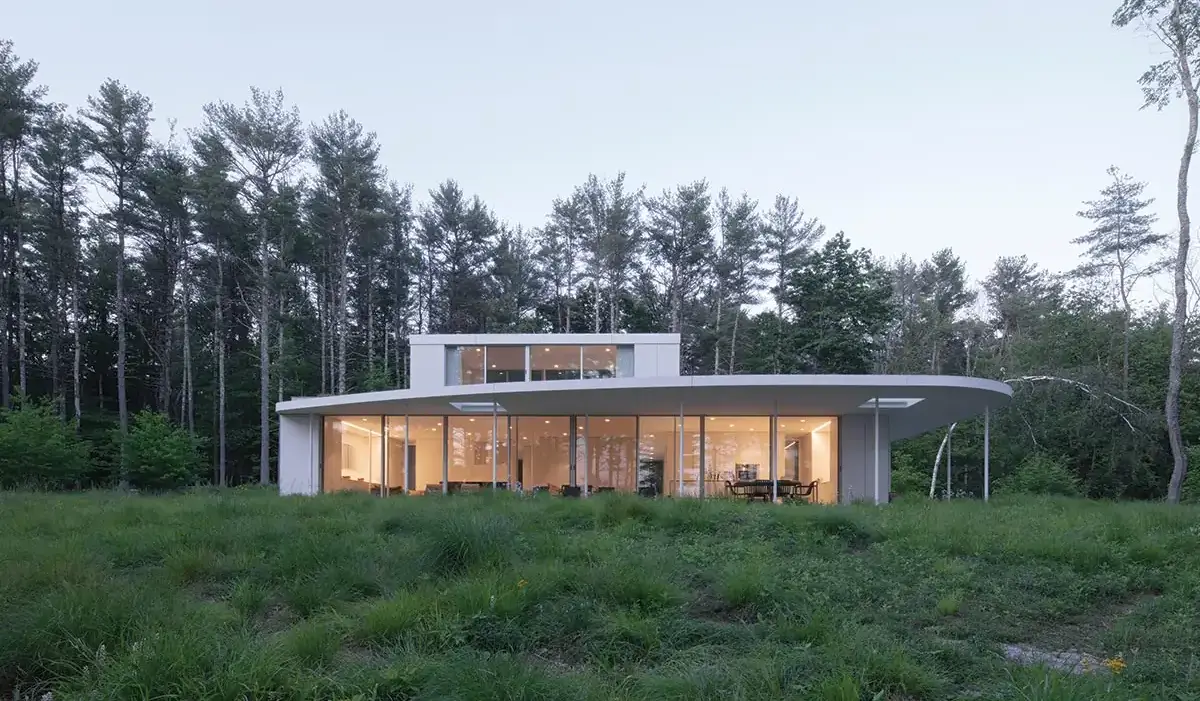
Calibrated to solar angles, the covered patio widens at the house’s southwest corner. Photo © Naho Kubota, click to enlarge.
“Jorn and Claudia’s care for this land is amazing,” Leven says, “and we thought a lot about how the architecture should sit in these surroundings.” For Ake, a writer and amateur naturalist, restoring the ecology of the couple’s wooded 80-acre property, portions of which under different stewards had accommodated a gravel pit, an auto graveyard, and a sheep farm, has been an ongoing but rewarding effort. The cars have been cleared, though it’s not unusual to still stumble upon a random part or two. Invasive plant species are routinely uprooted, and a creek is being remedied to reduce sedimentation. Not surprisingly, when it came time to build, architecture and landscape were carefully considered in tandem.
Ake and Salomon enlisted a botanist and an ecologist from the Farmscape Ecology program of the Hawthorne Valley Association—a local nonprofit with programming that integrates agriculture, education, and art—to survey flora on the vast property. In turn, landscape architect Jamie Purinton translated their catalogue of 102 species into a palette, specifying native plantings that would thrive around the house. That process, Leven adds, was a boon to thinking holistically about site. “It has completely changed how we approach our houses.”
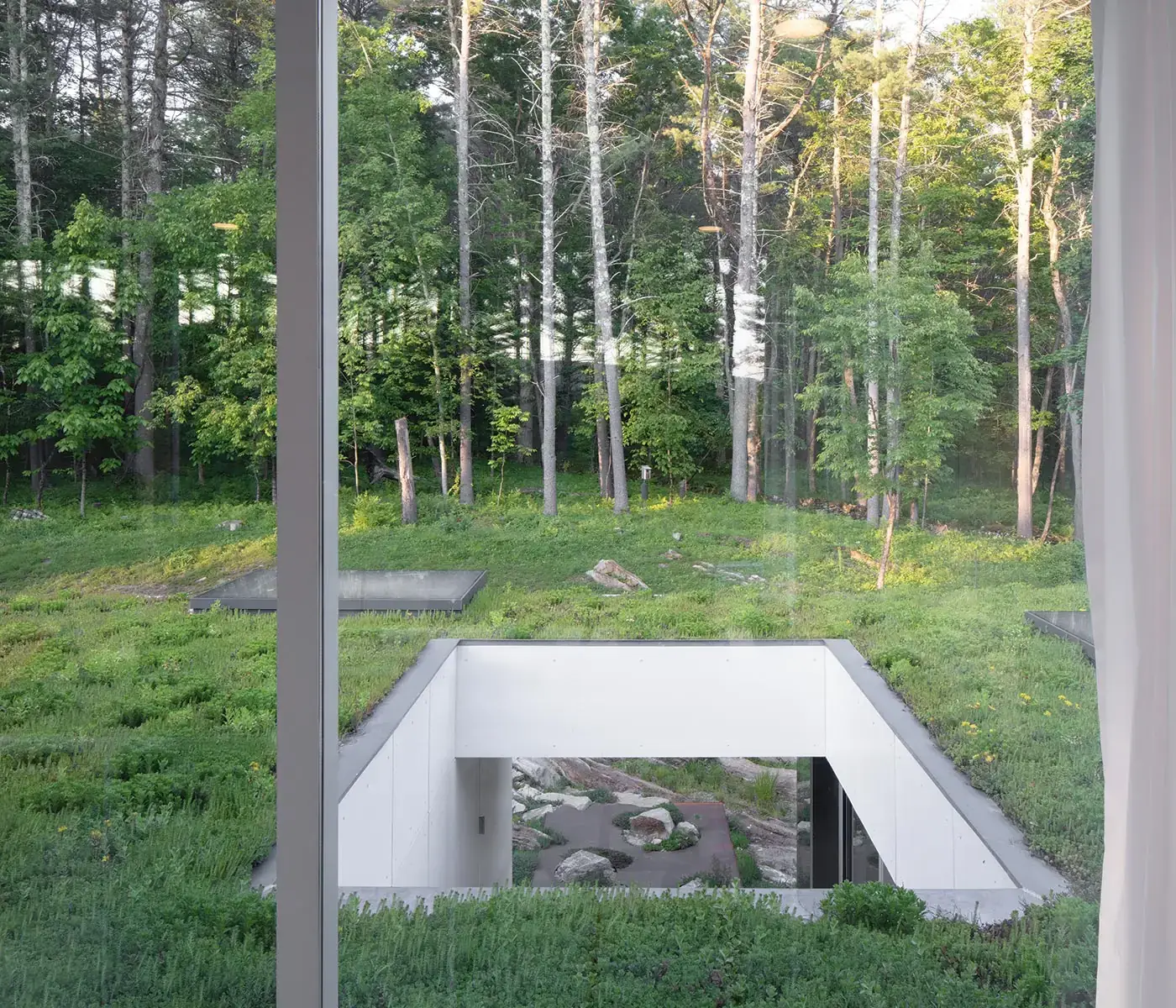
From the second floor, the house seems to disappear into the landscape. Photo © Naho Kubota
A winding pathway in picturesque countryside leads to the modest 2,500-square-foot SA House (so called for its owners’ surnames). From the vestibule, nature suddenly disappears. Solid, white interiors replace dappled foliage; the crunch of loose gravel underfoot becomes a hearty thud on polished-concrete floors. But this obfuscation is only momentary—with every turn into a new room, one sees the outside world come back into full view through floor-to-ceiling glass walls. To the west, the kitchen and living room overlook a valley through the same pines enshrouding the house on approach. To the northeast, the corner bedroom suite looks uphill into a dense woodland. “It’s better than television,” Ake says of the wildlife on display. “We wanted fresh air, light, and privacy—and we got two out of three,” he adds with a laugh, noting the many feathery and furry visitors that he and his wife encounter.
Ten rectangular volumes—some concealing storage, others inhabitable, one encasing a fireplace and chimney flue—are the devices that script movement, define space, and provide shear support on the ground floor. Each is clad in panelized fiber cement, affixed with button-head screws; this tectonic language is repeated continuously, inside and out. Overlaid atop this strictly orthogonal organizational system, 21 slender columns stipple the main level like saplings, structuring the roof and a boomerang-shaped covered patio. And overhead, as part of the lighting scheme by Suzan Tillotson, integrated downlights dot the ceiling like a constellation.
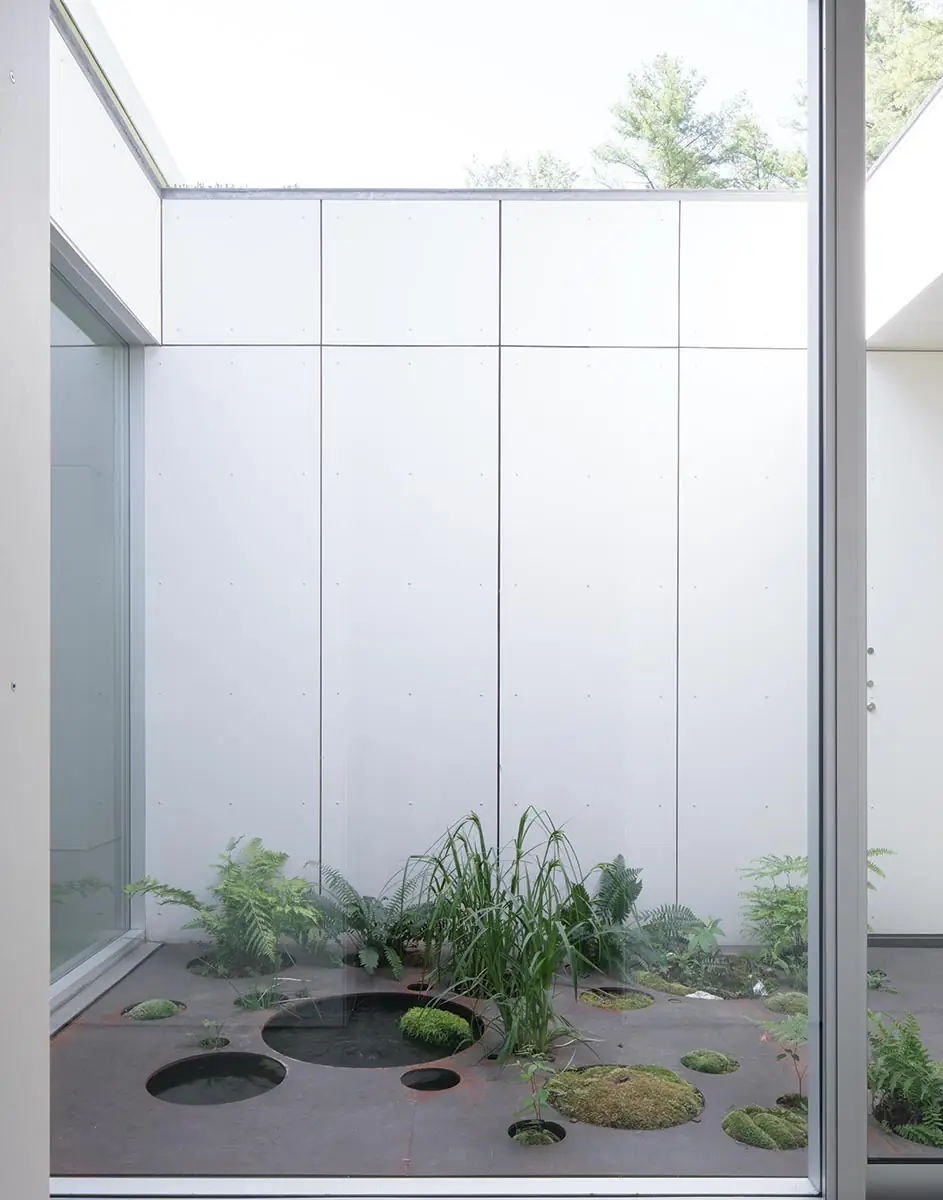
1
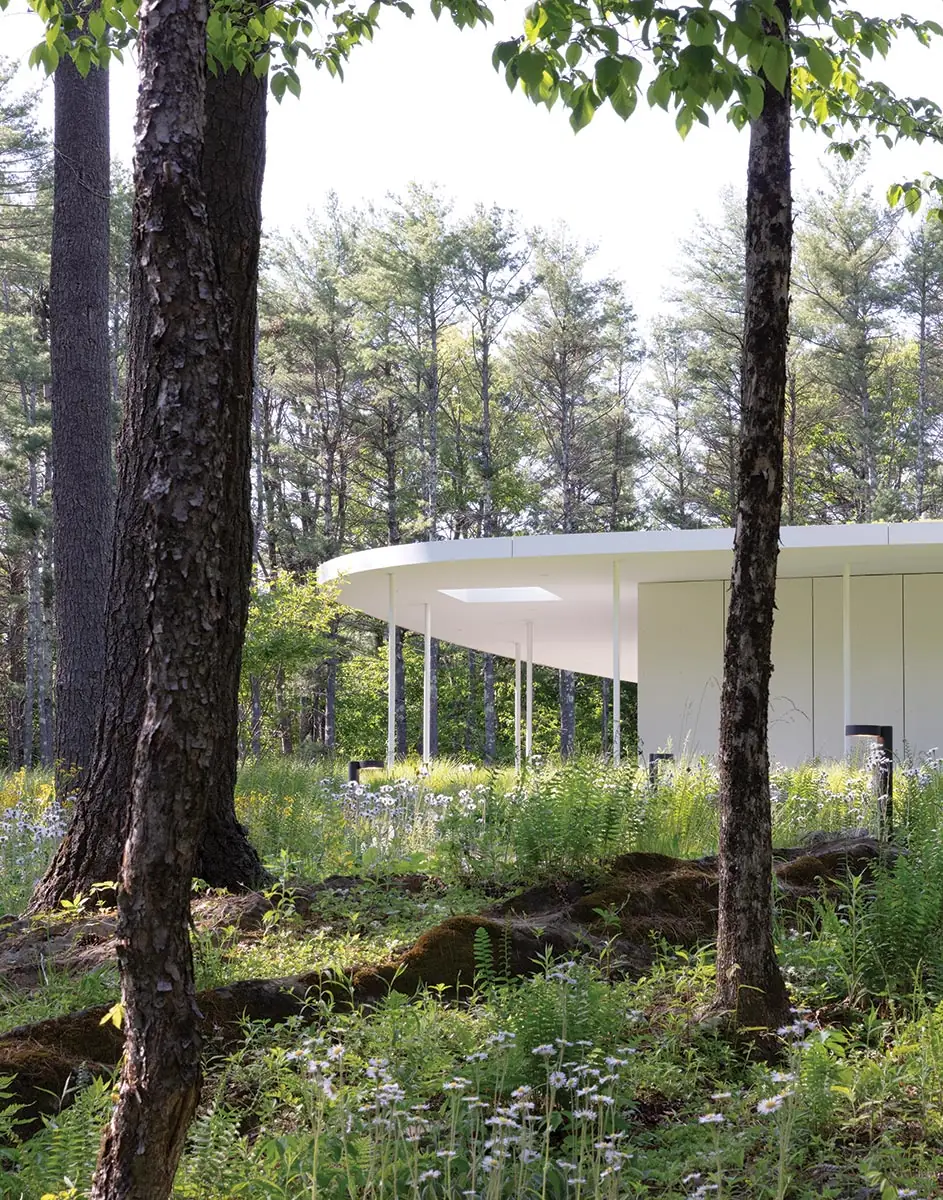
2
A light court brightens interiors (1). Slender columns echo the forest (2 & 3). Photos © Naho Kubota
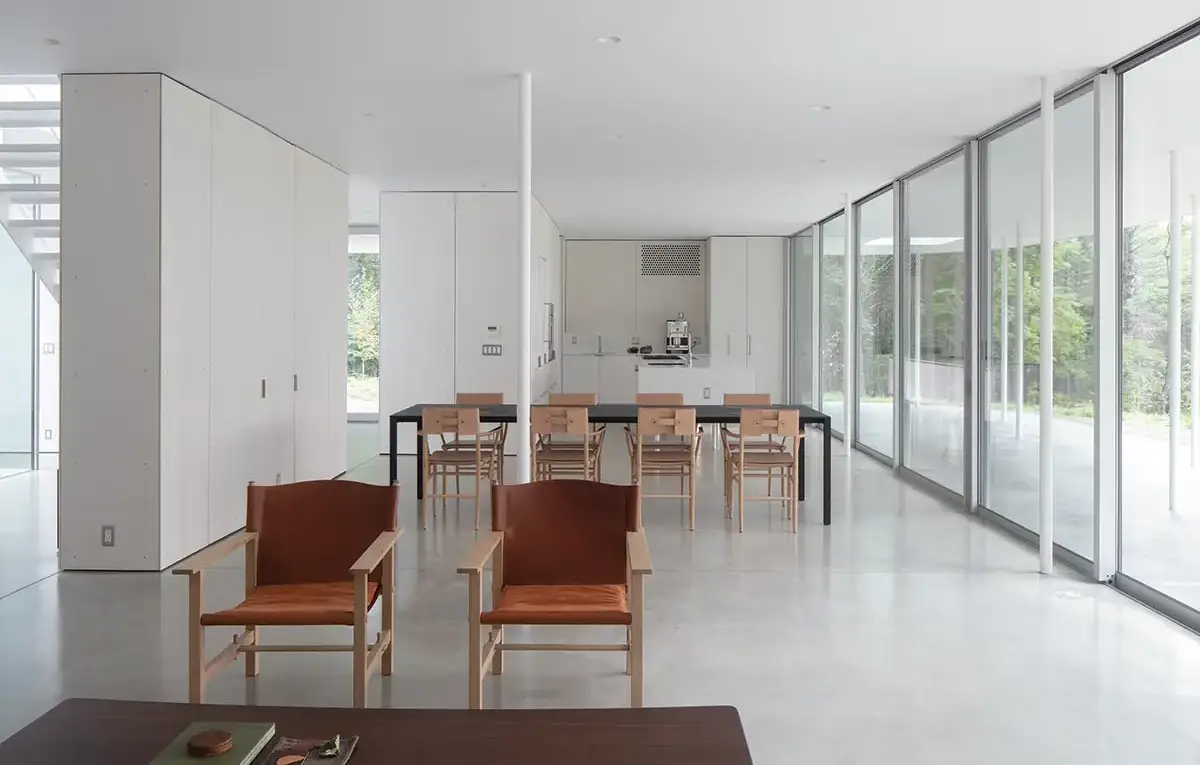
3
More striking is a 32-foot-long sculpture by Czech-American artists Kristyna and Marek Milde, which juts out from the east-facing light court directly into a dramatic, striated shale outcropping to which the house’s foundation is pinned. This plinth of weathering steel slots perfectly into the jagged stone, and circular cutouts accommodate ferns, moss, and a small pond frequented by amphibious critters.
At the house’s core, a steel staircase leads up to a tranquil second-floor study. From this elevated crow’s nest, a second vanishing act unfolds—densely planted sedum on the roof blurs almost indistinguishably into the surrounding meadow of sedge, rush, and aster (save an abstract smattering of openings and skylights). In the warmer months, the buzz of pollinators amid a sea of yellow blooms makes for a mesmerizing spectacle. But this roofscape, with thick wool padding underneath, serves a practical purpose too—with a measurable R value of 46, it acts as a “thermal sponge,” helping regulate the temperature of living spaces below. Out of view, a blind spot referred to by the architects as the “Bermuda Trapezoid” conceals a dryer vent and the stove exhaust from most vantage points—a clever solution to a perennial problem for houses experienced in the round.
Now that Ake and Salomon have put down roots and settled in, attention has shifted deeper into the woods. About 10 minutes away on foot, LEVENBETTS is busy developing a timber folly—a moment of respite along meandering trails. It’s a sign that the client-architect relationship is thriving, and that the house is just as perfectly attuned to its environs as it is to the occupants. Says Ake: “We asked Stella and David to design the house that we never knew we wanted.”
Click plan to enlarge
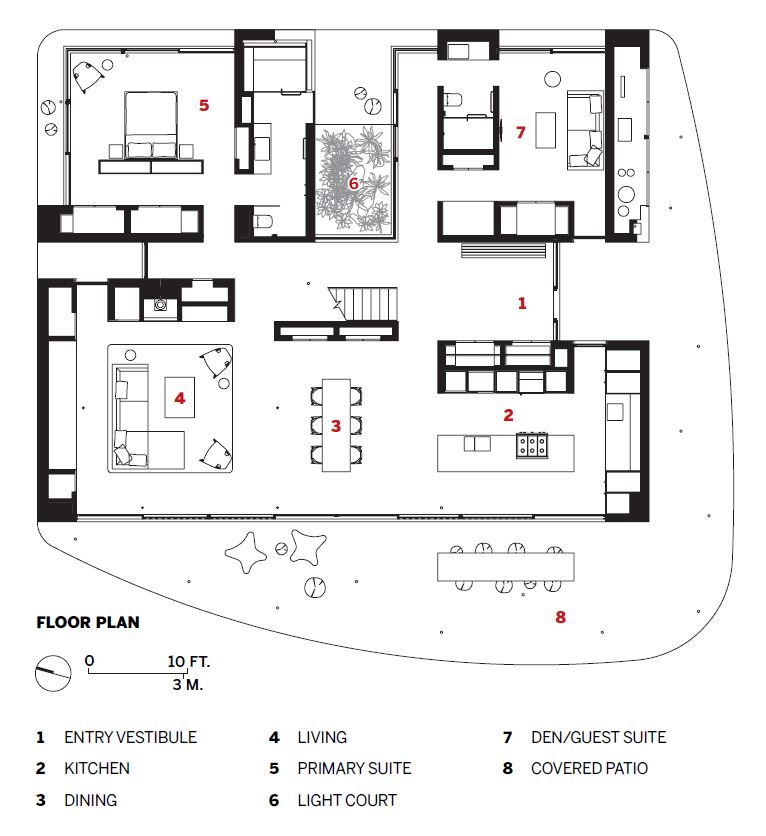
Credits
Architect:
LEVENBETTS — David Leven, Stella Betts, principals; Andrew Luy, project manager; Felipe Colin, You Chia Lai, Sasha Urano, Sungwhan Jean, Andrea Chiney, design team
Engineers:
Brett Schneider, Guy Nordenson and Associates (structural)
Consultants:
Tillotson Design Associates (lighting); Jamie Purinton Landscape Architect, Garden Tenders (landscape); Claudia Knab-Vispo, Conrad Vispo (survey)
General Contractor:
Richard McCue
Clients:
Claudia Salomon and Jorn Ake
Size:
2,500 square feet
Cost:
Withheld
Completion Date:
June 2023
Sources
Cladding:
Cement Board Fabricators
Roofing:
Kemper
Windows:
Fleetwood; Glazing Vision (skylights)
Doors:
Fleetwood (exterior); Centor Screens (integrated concealed screens); Solid Core (interior)
Hardware:
Accurate Pulls (locksets)
Interior Finishes:
Benjamin Moore Aura (ceiling paint); Dupont Corian (kitchen counter); Cement Board Fabricators (interior wall panels)
Lighting:
Lucifer (downlights); Bega, B-K Lighting (exterior); Lutron (dimming)
Plumbing:
MGS, Duravit, D Line



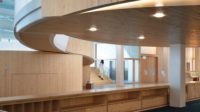

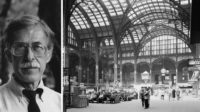
Post a comment to this article
Report Abusive Comment